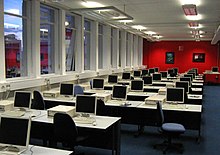

A desktop computer, often abbreviated as desktop,[1] is a personal computer designed for regular use at a stationary location on or near a desk (as opposed to a portable computer) due to its size and power requirements. The most common configuration has a case that houses the power supply, motherboard (a printed circuit board with a microprocessor as the central processing unit, memory, bus, certain peripherals and other electronic components), disk storage (usually one or more hard disk drives, solid-state drives, optical disc drives, and in early models floppy disk drives); a keyboard and mouse for input; and a monitor, speakers, and, often, a printer for output. The case may be oriented horizontally or vertically and placed either underneath, beside, or on top of a desk.
Desktop computers with their cases oriented vertically are referred to as towers. As the majority of cases offered since the mid-1990s are in this form factor, the term desktop has been retronymically used to refer to modern cases offered in the traditional horizontal orientation.[2][3]
- ^ "desktop". Collins Dictionary. Retrieved December 10, 2022.
- ^ Dennen, Ed (July 18, 1994). "How can it be a desktop if it isn't on top of the desk?". PC Week. 11 (28). Ziff-Davis: 69 – via Gale.
- ^ Prowse, David (2015). CompTIA A+ 220-901 and 220-902 Exam Cram. Pearson Education. p. 201. ISBN 9780134391496 – via Google Books.